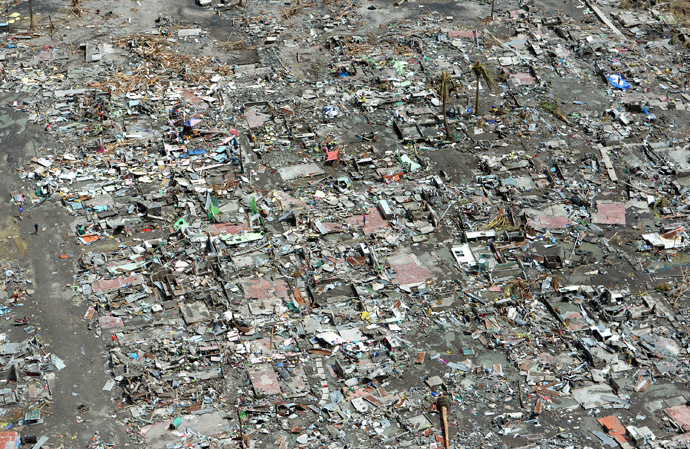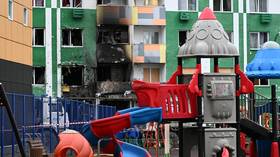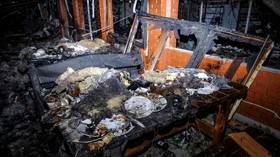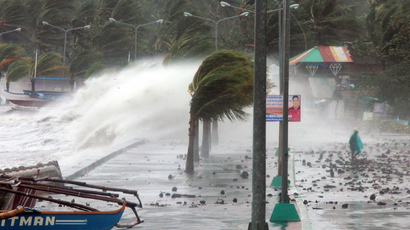Death, hunger, looting: Typhoon-ravaged Philippines' state of national calamity

In the wake of Typhoon Haiyan, which left thousands dead, many more displaced and survivors battling for survival amid devastation and chaos, the Philippines has declared a state of national calamity to help restore order to the reeling nation.
In a primetime television speech delivered Monday, President
Benigno Aquino said: "We declare a state of national calamity to
hasten the action of the government to rescue, provide help and
rehabilitate the provinces affected by [Haiyan]."
The declaration will also help the government control the prices
of staple goods, with many in the country reduced to begging for
food and water. Aquino called for patience as the scope of the
damage frustrated efforts to coordinate relief operations.
“The extent of the devastation brought us back to a situation
where information was passed on from one person to another. There
was no television, radio and internet,” he said.
Noting how the devastation reduced people to word-of-mouth
communication, Aquino vowed help would arrive in the coming days.
"My message: Staying calm, prayer, and helping each other are
what will lift us from this challenge," he said.

Counting the dead, accounting for the missing
Three days after the typhoon made landfall, authorities are
struggling to come to grips with the aftermath of one of the
strongest typhoons ever recorded.
Forty-one of the country’s 80 provinces were affected, with
Secretary to the Cabinet Rene Almendras saying that in the worst
affected areas, the destruction had been “total.”
An estimated 10,000 people are believed to have been killed in
Tacloban – a city of over 200,000 southeast of the capital,
Manila – which bore the brunt of the storm. Flattened by massive
waves and battered by winds reaching speeds up to 235 miles an
hour, Tacloban remains littered by the dead, some covered with
tarps, others left lying out in the open with looks of horror
reportedly etched on their faces. The United Nations said
officials in Tacloban had seen one mass grave of 300 to 500
bodies, Reuters reported. Relief workers fear that ground water
may be contaminated by decaying bodies, and fears are growing of
a massive public health crisis.
The city has also been gripped by looting, with authorities
dispatching police and military reinforcements to restore order.
A Philippine Red Cross truck carrying medical supplies was
reportedly attacked while heading to the city. Manila has said it
will not hesitate in deploying more police officers if necessary.
Locals have already reportedly formed local militias and have
promised to shoot looters to protect their property.

So far, Tacloban is relying almost entirely for supplies and
evacuation on just three military transport planes flying from
nearby Cebu. Aquino said 24,000 family food packs had been
distributed in Tacloban on Sunday, while 18.7 billion pesos ($430
million) had been set aside from calamity funds, contingency
funds, and savings for places hit by Haiyan.
Around 2,000 people, meanwhile, remain missing in the seaside
town of Basely alone, which is located about 10 kilometers across
a bay from Tacloban. Other coastal areas caught on Haiyan's path
are likely to have suffered similar levels of destruction, though
efforts to survey the damage or make a full account of the dead
have been severely dampened.
The country’s government has so far confirmed 1,744 deaths.
Both the official and unofficial death tolls are likely climb
once officials reach more remote areas. Guiuan, a town of 40,000
in eastern Samar province, was largely decimated, although it
does not figure into the casualty tabulations.

"The only reason why we have no reports of casualties up to now is that communications systems ... are down," Colonel John Sanchez posted on the Philippines Armed Forces’ Facebook page, Reuters reported.
Farther west on the on the islands of Cebu and Panay, which also suffered direct hits from the typhoon, authorities have been hampered in their ability to assess the devastation.
Overall, more than 600,000 people were displaced by the storm across the country, with some lacking access to basic amenities such as food, water or medicine, the UN says.

Massively disrupted transportation and communications links have equally affected the ability for authorities to recover the dead and deliver relief to affected areas. Thirty provinces remain without electricity, and around half that number are having problems with phone and Internet connections. Although telecommunication firms believe service should be restored within days, restoring the national power grid in its entirety could take up to two months.
The US is sending an aircraft carrier in order to bolster the relief efforts, the Pentagon confirmed Monday. The nuclear-powered USS George Washington carries 5,000 sailors and more than 80 aircraft.
Meanwhile, Russia is dispatching a mobile hospital and rescue workers to the Philippines.
President Aquino said 21 other countries had provided aid,
including Indonesia, the UK, Japan, Singapore, New Zealand and
Hungary.














